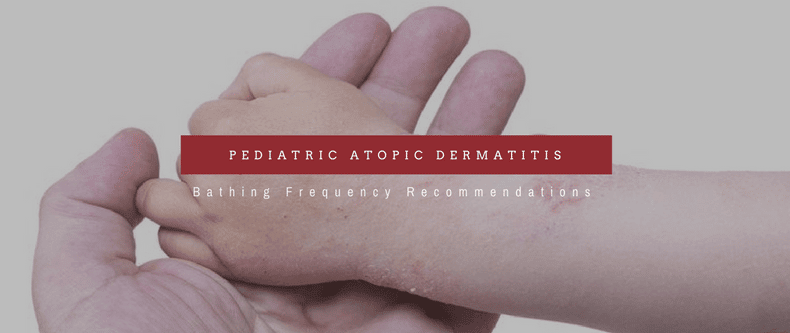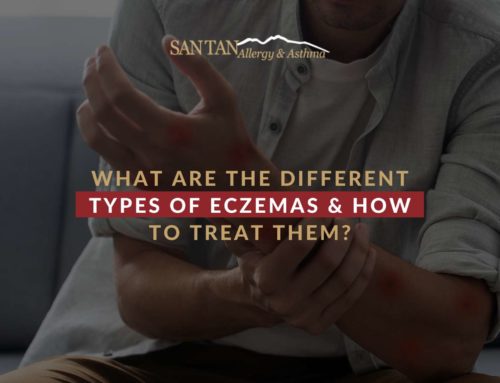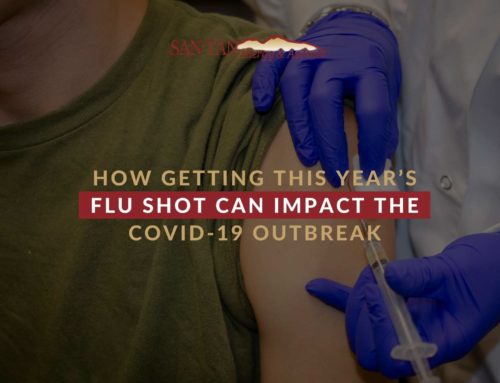
[2] Murota H, Takahashi A, Nishioka M, et al. Showering reduces atopic dermatitis in elementary school students. Eur J Dermatol. 2010;20:410e411.
Mochizuki H, Muramatsu R, Tadaki H, Mizuno T, Arakawa H, Morikawa A.
[3] Effects of skin care with shower therapy on children with atopic dermatitis in elementary schools. Pediatr Dermatol. 2009;26:223e225.
[4] Kameyoshi Y, Tanaka T, Mochizuki M, et al. Taking showers at school is beneficial for children with severer atopic dermatitis. Aerugi. 2008;57:
130e137.[/note] Consequently, the jury remains out on this topic. Hence, there is likely to be confusion when AD guidelines have not provided clear and consistent evidence-based advice in this area.[note][5] Schneider L, Tilles S, Lio P, et al. Atopic dermatitis: a practice parameter update 2012. J Allergy Clin Immunol. 2013;131:295e299.
[6] Ring J, Alomar A, Bieber T, et al. Guidelines for treatment of atopic eczema (atopic dermatitis) part I. European Dermatology Forum; European Academy of Dermatology and Venereology; European Federation of Allergy; European Task Force on Atopic Dermatitis; European Society of Pediatric Dermatology; Global Allergy and Asthma European Network. J Eur Acad Dermatol Venereol. 2012;26:1045e1060.
[7] Saeki H, Furue M, Furukawa F, et al. Guidelines for management of atopic dermatitis. J Dermatol. 2009;36:563e577.
[8] Akdis CA, Akdis M, Bieber T, et al. European Academy of Allergology; Clinical Immunology/American Academy of Allergy, Asthma and Immunology/PRAC-TALL Consensus Group. Diagnosis and treatment of atopic dermatitis in children and adults: European Academy of Allergology and Clinical Immunology/American Academy of Allergy, Asthma and Immunology/PRACTALL Consensus Report. J Allergy Clin Immunol. 2006;118:152e169.[/note] Two recent practice guidelines from the United States[note][5] Schneider L, Tilles S, Lio P, et al. Atopic dermatitis: a practice parameter update 2012. J Allergy Clin Immunol. 2013;131:295e299.[/note] and Europe[note][6] Ring J, Alomar A, Bieber T, et al. Guidelines for treatment of atopic eczema (atopic dermatitis) part I. European Dermatology Forum; European Academy of Dermatology and Venereology; European Federation of Allergy; European Task Force on Atopic Dermatitis; European Society of Pediatric Dermatology; Global Allergy and Asthma European Network. J Eur Acad Dermatol Venereol. 2012;26:1045e1060.[/note] fail to comment entirely on bathing frequency. Instead they focus on duration of bathing based on expert opinion: US guidelines recommend at least 10-minute soaking baths,[note][5] Schneider L, Tilles S, Lio P, et al. Atopic dermatitis: a practice parameter update 2012. J Allergy Clin Immunol. 2013;131:295e299.[/note] and European guidelines recommend short, 5-minute baths.[note][6] Ring J, Alomar A, Bieber T, et al. Guidelines for treatment of atopic eczema (atopic dermatitis) part I. European Dermatology Forum; European Academy of Dermatology and Venereology; European Federation of Allergy; European Task Force on Atopic Dermatitis; European Society of Pediatric Dermatology; Global Allergy and Asthma European Network. J Eur Acad Dermatol Venereol. 2012;26:1045e1060.[/note] Our goal was to determine what parents of children with AD interpret from their providers concerning bathing frequency. Given the lack of clarity in AD guidelines, we hypothesized that advice received by parents concerning bathing frequency in AD would lack consistency and subsequently contribute to further confusion and frustration in this often difficult to manage disease.
In testing this hypothesis, an online institutional review boardeapproved 7-question survey was posted to the National Eczema Association (NEA) website, quarterly electronic newsletter, and Facebook page. The NEA is a nonprofit organization dedicated to AD research, education, and advocacy. Membership includes parents of pediatric patients with AD. The survey was posted for a period of 6 weeks in the spring of 2012, and members of the NEA were invited to participate voluntarily and anonymously by clicking a SurveyMonkey link. Participation implied consent. The survey questions can be found in Table 1 below. Confidence intervals (CIs) were calculated using an online statistical computation tool available through Vassar Stats.
A total of 354 NEA members responded to the survey. Basic demographics were gathered on which health care providers parents see for their child’s AD. The focus was on frequency, not method of bathing; showers vs soaking baths were not distinguished, although this too remains an area of uncertainty.9 With regard to moisturizing, there is general agreement within AD guidelines that emollients should serve as first-line therapy. We chose to focus on the area of bathing frequency, where the guides were lacking.
The results of the survey are found in Table 1 below. Most parents see a specialist for their child’s AD. Of those, 82.7% had been referred to a dermatologist, and 49.8% to an allergist/immunologist. Parents reported that their primary care provider (PCP) recommended “frequent/daily bathing” less than 50% of the time, whereas they reported their specialist recommended “frequent/daily bathing” more than 50% of the time (with nonoverlapping CIs). Of those who had seen a specialist or multiple providers, 45.6% had received conflicting advice about bathing, and of those, 76.4% felt this caused frustration and confusion.

This survey did not compare recommendations between specialists and PCPs; however, parent interpretation of provider recommendations is actually consistent with previous surveys of physicians done by the authors. For instance, in a survey of 904 American Academy of Allergy Asthma and Immunology members, 57.01% (95% CI 53.83%e60.27%) recommended “frequent/daily bathing,” which closely approximates parents’ response to question 5.[note] [10] Kempe EE, Jain N, Cardona ID. A pilot survey of wet vs. dry treatment strategies for atopic dermatitis among allergy and immunology physicians. Ann Allergy Asthma Immunol. 2011;107(suppl 1): P379:A124.[/note] Likewise, in a pilot survey of 37 members of the society of pediatric dermatology, 62% (95% CI, 46.1%e75.9%) recommended “frequent/daily bathing” (author’s unpublished data), demonstrating that frequent/daily bathing seems preferred by specialists who have experience in AD management. On the contrary, the opposite seems to be the case amongst PCPs. In a survey of 145 members of the Maine Chapters of the American Academy of Pediatrics and American Academy of Family Physicians, pediatricians and family physicians recommended frequent/daily bathing 28% (95% CI, 19%e41%) and 15% (95% CI, 9%e24%) of the time, respectively (2013 ACAAI abstract submission). The numbers are small but the trend is consistent with how parents answered question 4. Taken together, the difference of opinion that caused confusion in parents may have come from those who saw multiple providers, or saw a PCP then later saw a specialist (question 6).
Although we are confident in the validity of our results, one limitation of this study is that we did not ask families whether their provider tailored their bathing strategy specifically to their child. Possibly a proportion of the 54.4% who did not receive conflicting advice may have fallen into this category. In addition, we did not gather demographic information from the NEA population we surveyed, diminishing the generalizability of our findings. For instance, we do not know the eczema severity of the children with AD, although one might imagine it could be skewed toward a more severe phenotype, because most parents reported seeing a specialist for their child’s AD. The parent of a child with severe AD may be more motivated to be involved with the NEA and thus could be more “eczema-savvy” than the average parent, potentially underestimating the percentage of parents who are confused by bathing instructions. Conversely, such a parent could also be more prone to frustration as well. Finally, we cannot be certain how many parents, of the 76.4% who reported being frustrated and confused, pursued providers that gave recommendations that reflected their own beliefs. Quantifying this via a survey would be difficult.
In summary, this survey of parents of children with AD, albeit of limited sample size and from a specific parent-patient population, has demonstrated that parents report disagreement between PCPs contributes to a high degree of frustration and confusion among families. Although the variability among providers may have been expected thanks to silence from AD guidelines, to our knowledge this is the first report to highlight that we may be doing a disservice to families by not having a unified voice on the subject. Until further studies are done to identify whether frequent bathing or infrequent bathing is more effective, providers should consider an empirical approach tailored to each individual patient.
Written By:
Erin Kempe, DO, Maine Medical Center
Neal Jain, MD, San Tan Allergy and Asthma
Ivan Cardona, MD, Allergy and Asthma Associates of Maine







